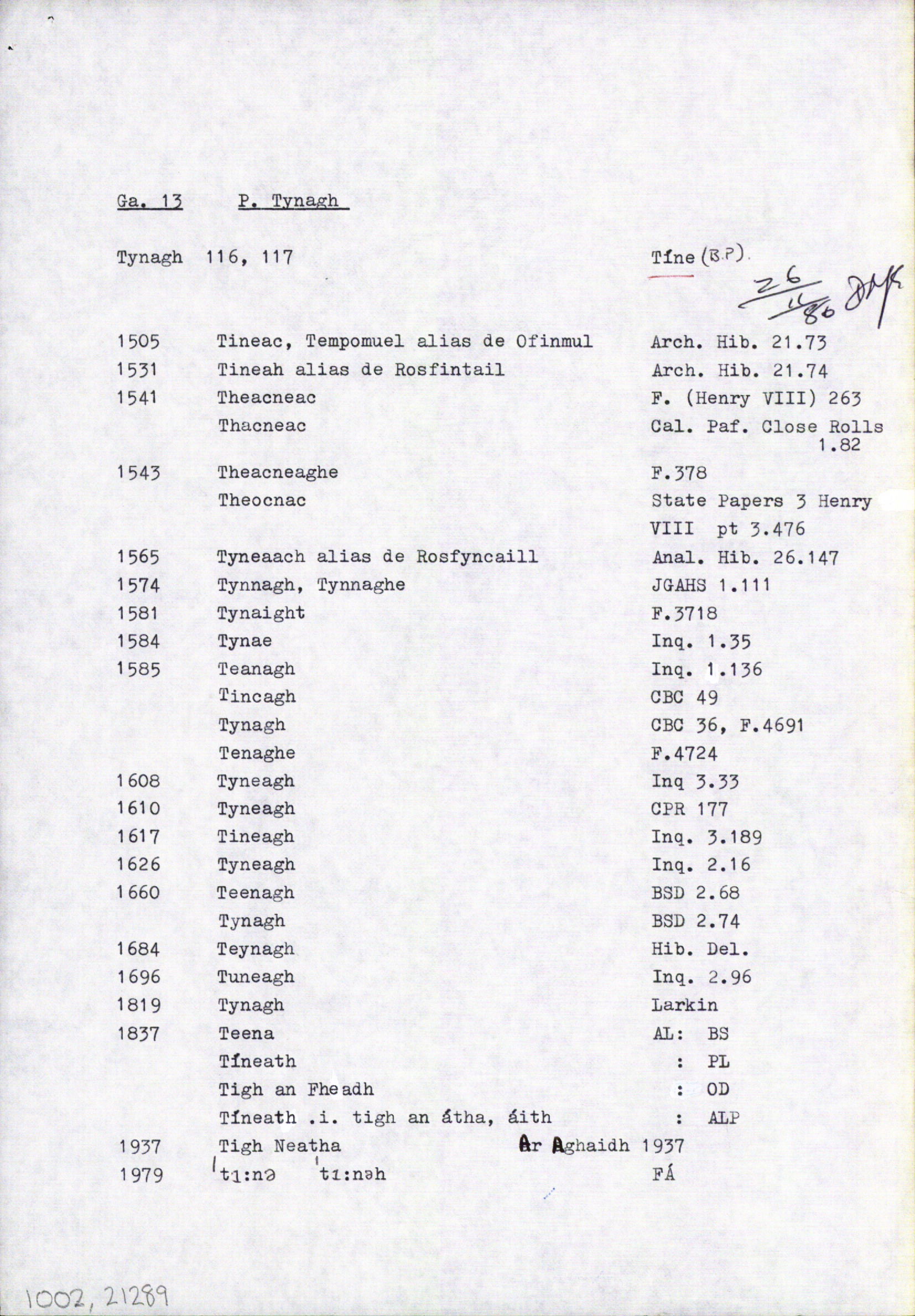Ordlathas
contae
barúntacht
paróiste dlí
fo-aonaid
Nóta mínithe
- English
Tíne is the legal Irish version of Tynagh according to the Placenames (Centres of population and districts) Order 2005 which was made by the Minister for Community, Rural and Gaeltacht Affairs on the advice of the Placenames Commission under the terms of the Official Languages Act 2003. This version has had official status since 1969 and legal status since 1975 under the terms of the Placenames (Irish forms) Act 1973. Tíne has been the official Irish name since 1969, when it was included in the publication Ainmneacha Gaeilge na mBailte Poist --- a bilingual list of the post-towns of Ireland -- prepared by An Coimisiún Logainmneacha. Provisional lists of the placenames were published in book-form prior to the publication of the official list, in order to allow the public the opportunity to comment on the recommended Irish forms.
Tighneatha was recommended for use in a gazetteer of postal towns called Post-Sheanchas published in 1905. It subsequently gained some currency mainly through its use by the postal authorities. Tighneatha (written as one word) is best regarded as an effort at writing a placename that had become opaque. In fact Tighneatha is meaningless in Irish. As already mentioned, Tíne has been the official Irish name since 1969, when it was included in the publication Ainmneacha Gaeilge na mBailte Poist --- a bilingual list of the post-towns of Ireland -- prepared by An Coimisiún Logainmneacha. Provisional lists of the placenames were published in book-form prior to the publication of the official list, in order to allow the public the opportunity to comment on the recommended Irish forms. The former Chief Placenames Officer, Dónall Mac Giolla Easpaig has demonstrated in a number of articles that the original Irish name of Tynagh was Teach nEachach. Dónall also noted the linguistic changes that preceded the modern pronunciation of the name. To quote directly from his article in Galway – History and Society: ‘Through a long process of linguistic change Teach nEachach, which signifies “Eochu’s house”, became Tigh nEathach and eventually Tíne’. Local information obtained by the Ordnance Survey staff, who consulted with Irish speakers in the area in 1838, demonstrates that most of the linguistic changes, as outlined by Mac Giolla Easpaig (Ainm, vol. I), had already occurred by then, including the shift of stress accent to the initial syllable of the name. Tíne, the official Irish spelling, reflects the culmination of that linguistic process.
Lárphointe
Aire: Cáipéisíocht áirithe chartlainne de chuid an Bhrainse Logainmneacha í seo. Léirítear anseo cuid de réimse thaighde an Bhrainse Logainmneacha ar an logainm seo thar na blianta. D'fhéadfadh sé nach taifead iomlán é agus nach bhfuil aon rangú in ord bailíochta déanta ar an bhfianaise atá ann. Is ar an tuiscint seo atá an t-ábhar seo á chur ar fáil don phobal.
Is féidir leas a bhaint as an ábhar cartlainne agus taighde atá curtha ar fáil ar an suíomh seo ach an fhoinse a admháil. Ní mór scríobh chuig logainm@dcu.ie chun cead athfhoilsithe nó saincheisteanna eile maidir le ceadanna nó cóipcheart a phlé.

